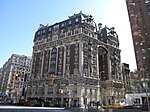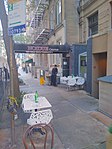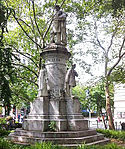Church of the Blessed Sacrament (Manhattan)
1887 establishments in New York (state)20th-century Roman Catholic church buildings in the United StatesGothic Revival church buildings in New York CityGustave E. Steinback church buildingsManhattan church stubs ... and 4 more
Religious organizations established in 1887Roman Catholic churches completed in 1920Roman Catholic churches in ManhattanUpper West Side

The Church of the Blessed Sacrament is a Roman Catholic parish church in the Roman Catholic Archdiocese of New York, located in the Upper West Side of Manhattan at 152 West 71st Street, just east of Broadway. The parish was established in 1887. The present church was started in 1914 to designs by Gustave E. Steinback and the first mass was held on Christmas 1920.The Arclight Theatre is located on the lower level.
Excerpt from the Wikipedia article Church of the Blessed Sacrament (Manhattan) (License: CC BY-SA 3.0, Authors, Images).Church of the Blessed Sacrament (Manhattan)
West 71st Street, New York Manhattan
Geographical coordinates (GPS) Address Website External links Nearby Places Show on map
Geographical coordinates (GPS)
| Latitude | Longitude |
|---|---|
| N 40.777222222222 ° | E -73.981166666667 ° |
Address
Church of the Blessed Sacrament (Blessed Sacrament Church)
West 71st Street 152
10023 New York, Manhattan
New York, United States
Open on Google Maps








